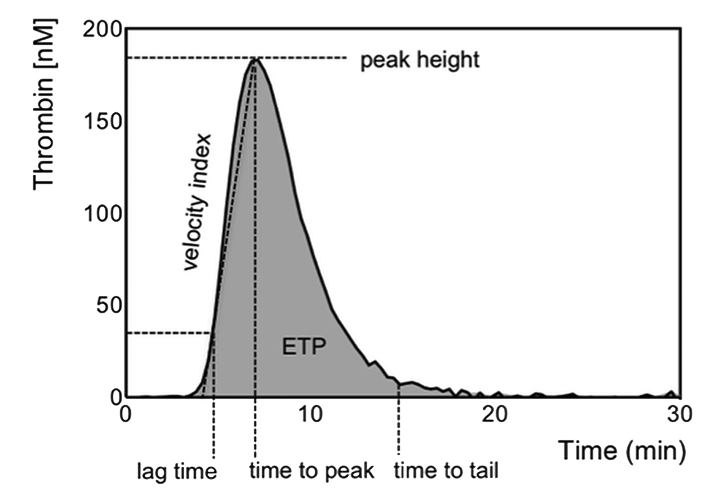Thrombin Generation (PPP, PRP, WB)

The lag time is the time needed to form the first traces of thrombin, the ETP represents the total amount of active thrombin formed during thrombin generation and the peak height the maximal amount of thrombin formed.
Numerous articles have shown that an increased thrombin generation is associated with thrombosis, whereas a decrease in thrombin generation is associated with bleeding.
Thrombin generation by means of the CAT assay can be used for several applications, including:
- To monitor the use of antithrombotic therapy, e.g. treatment with direct oral anticoagulants (e.g. Dabigatran, Rivaroxaban), vitamin K antagonists (e.g. warfarin), heparins (e.g. unfractionated heparin, low molecular weight heparin) and antiplatelet drugs (e.g. Clopidogrel)
- To support the development of antithrombotic drugs, such direct inhibitors of thrombin or FXa
- To determine the coagulation state of patients at increased risk of thrombosis or bleeding
- To monitor patients with hemophilia, such as treatment with FVIII concentrates or treatment with FVIIa (NovoSeven)
- To measure genetic and acquired thrombotic disorders, e.g. deficiency in antithrombin (AT)
- To determine thrombogenic capacity of materials
- To quantify the levels of coagulation factors in low sample volumes
- To elucidate coagulation mechanisms
Thrombin generation triggered with tissue factor can be measured in platelet poor plasma (PPP), platelet rich plasma (PRP) and whole blood. The conditions of the thrombin generation assay can be modified to better accommodate the question at hand. For example, the addition of thrombomodulin to the trigger allows to include the contribution of the protein C pathway to thrombin generation.
References:
Bloemen S, Huskens D, Konings J, Kremers R, Miszta A, de Laat B, Kelchtermans H. Interindividual variability and normal ranges of whole blood and plasma thrombin generation. JALM. 2017 Sept; 2 (2): 150 -164.
Huskens D, Sang Y, Konings J, van der Vorm L, de Laat B, Kelchtermans H, Roest M. Standardization and reference ranges for whole blood platelet function measurements using a flow cytometric platelet activation test. PLoS One. 2018 Feb 1;13(2):e0192079.


